INSIDE SCAIFE HALL
FROM DRONES TO BIODEGRADABLE ROBOTS
CULINARY MECHANICS
AI IN MECHANICAL ENGINEERING
INNOVATING THE TRADING CARD INDUSTRY
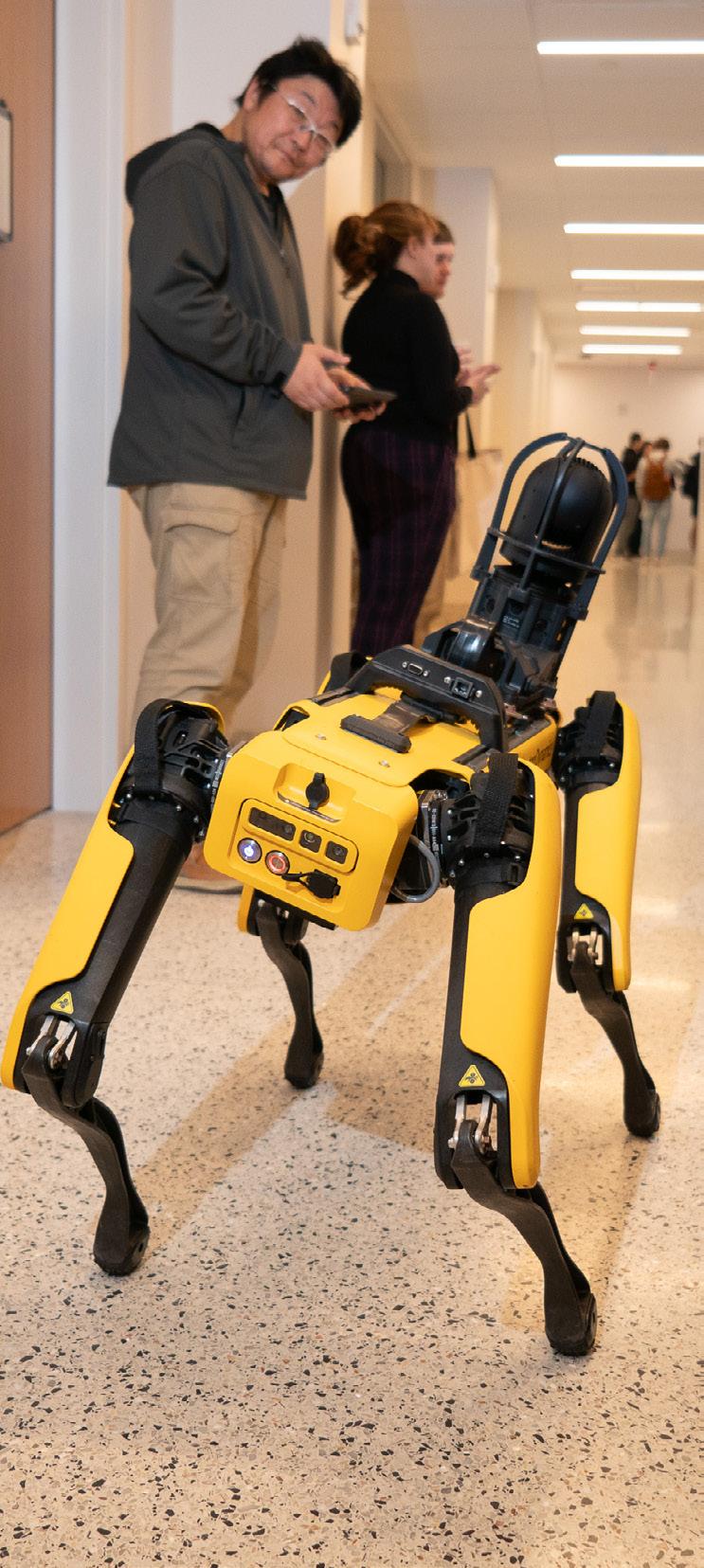
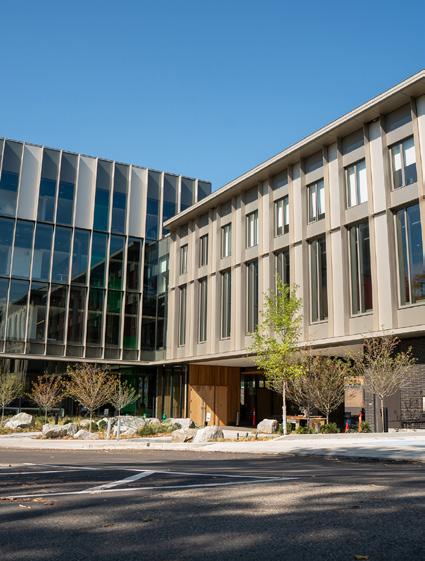

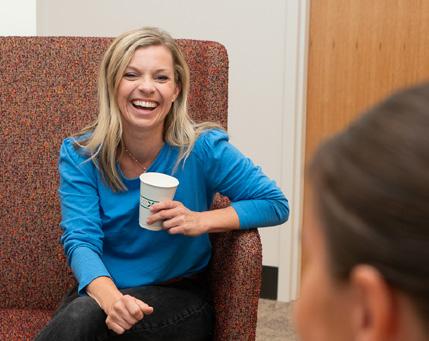
Mellon University | Winter 2024
Carnegie




Kaitlyn Landram, Communications Manager
Kaitlyn Landram, Lynn Shea, Pamela Smith, Holly Stokes
Debra Vieira, Senior Multimedia Designer, College of Engineering
Carnegie Mellon University does not discriminate in admission, employment, or administration of its programs or activities on the basis of race, color, national origin, sex, handicap or disability, age, sexual orientation, gender identity, religion, creed, ancestry, belief, veteran status, or genetic information. Furthermore, Carnegie Mellon University does not discriminate and is required not to discriminate in violation of federal, state, or local laws or executive orders.
Inquiries concerning the application of and compliance with this statement should be directed to the university ombudsman, Carnegie Mellon University, 5000 Forbes Avenue, Pittsburgh, PA 15213, telephone 412-268-1018.
Obtain general information about Carnegie Mellon University by calling 412-268-2000.
Inside 2 20 Alumni Accolades 25 The Mechanical Engineering community continues to push the boundaries of innovation, design, and discovery in the re-imagined Scaife Hall. ON THE COVER PUBLISHER EDITOR WRITERS DESIGN AI Engineering 14 Student Stories Scaife Hall New faculty and staff 32
of Mechanical Engineering
Department

Dear Alumni, Students, Parents, and Friends,
It’s been a busy year in MechE! We moved into our new home on campus — The Alan Magee Scaife Hall, introduced a new online graduate certificate program in AI Engineering, and welcomed two new faculty members.
In these pages, you’ll catch a glimpse inside the labs of Scaife Hall where Kenji Shimada’s drones navigate dynamic environments; Doug Weber is using spinal cord stimulation to offer hope for people living with paralysis after stroke; and Vickie Webster-Wood is building biodegradable robots.
As artificial intelligence continues to make headlines altering how we work, our faculty are preparing the next generation of engineers to integrate AI in the constraints of engineering problems. With the success of our new master’s program, we have decided to share our faculty expertise with practicing engineers via a new online certificate program.
As always, I am delighted to celebrate our students’ accolades and outreach efforts, including the sixth year of our bold initiative to make hockey safer: Rethink the Rink.
I hope you’ll enjoy hearing from our inventive and compassionate alumni and consider connecting with our new alumni relations manager, Courtney Schreiner, who is featured on page 32.
I wish you the best in 2024 and hope to see you at Spring Carnival (April 11-14).
Sincerely,
 Jon Cagan
David and Susan Coulter Head of Mechanical Engineering
George Tallman and Florence Barrett Ladd Professor
Jon Cagan
David and Susan Coulter Head of Mechanical Engineering
George Tallman and Florence Barrett Ladd Professor
MECHANICAL ENGINEERING 1


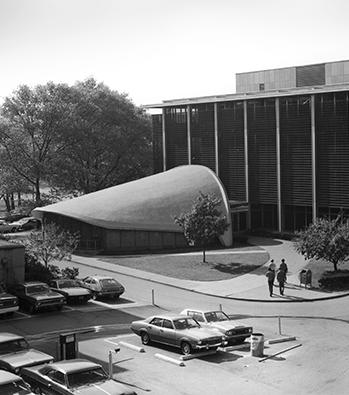



MECHANICAL ENGINEERING 2 MECH E inside: SCAIFE HALL
SCAIFE HALL
The Carnegie Mellon community came together to celebrate the grand opening of the reimagined Alan Magee Scaife Hall last fall
Since its grand opening in 1962, the Alan M. Scaife Hall has been the home of discovery, innovation, and mechanical engineering education at Carnegie Mellon University. Nevertheless, over the last sixty years technology has transformed; our smartphones have more processing power than the state-of-the-art computer that occupied the entire fourth floor (and had to be carried in via helicopter), and building robots from living tissue is no longer only possible in science fiction.
The future of engineering education and research requires very different classrooms and laboratories. The new Scaife Hall was built to not only accommodate CMU’s growing mechanical engineering community, but to spark innovation, create real-world impact, and foster the College of Engineering’s culture of Advanced CollaborationTM
By physically situating diverse research groups together to spark spontaneous interaction, Scaife Hall is accelerating multidisciplinary research in emerging fields across Carnegie Mellon University including biohybrid robotics and nanoengineered materials.
With reconfigurable classrooms and other modern learning spaces, students have more flexible project spaces for hands-on courses.
On top of that, the new Scaife Hall offers an improved sense of community for students, faculty, researchers, and staff. With more collaboration spaces and closer proximity between students and faculty, the department organically sees more light-bulb moments that are only possible when one bumps into their colleague or professor in the hallway.
“Scaife Hall empowers the people of Mechanical Engineering and Carnegie Mellon to advance, lead, and create a future for education and research for the rest of the 21st century and beyond,” said Jon Cagan, Mechanical Engineering Department Head and Professor.
MAKING WAY: THE ART OF SCAIFE HALL
The colorful wall paneling and light fixtures throughout the building are the work of esteemed installation artist Jessica Stockholder. The artwork - Making way - sits both inside and outside, supported and contained by the building’s structure and the landscape design. The artwork does not stay within the lines. It slips in and out of the forms established by the site and opens up a space for imagining the many pathways open to us within any structure or system. The static light cast by the street lamps, which are positioned both in and outside of the building, are in contrast to the shifting light cast by the sun, and the colors on the wall, the floor, and in the glass shift with the sun’s movement. Likewise, moving one’s body through the work provides ever shifting points of view, and inflects the present moment with the accumulation of experiencing the artwork over-time.
Jessica Stockholder was born in 1959 in Seattle, Washington. She has exhibited widely in museums and galleries internationally. Her work is represented in the permanent collections of numerous museums including the Whitney Museum of Art, New York; The Art Institute of Chicago; MoCA LA; SF MoMA; the Museum of Fine Arts, Boston; The British Museum, London; and the Stedelijk Museum, Amsterdam.

MECHANICAL ENGINEERING 3
INSIDE THE LABS OF SCAIFE HALL



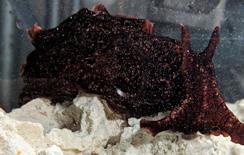

TISSUE CULTURE: How can we bring biological sensors and actuators to a wide range of robotic platforms? Researchers are exploring this for medical, environmental monitoring, and symbiotic applications.
ROBOTICS: Find researchers studying and developing better AI for autonomous vehicles and robots that can perform tasks too dangerous or difficult for humans.
AQUATICS: The home to bioinspiration and marine invertebrates such as sea slugs. Researchers will use this space to test biohybrid robotic materials and aquatic robotic platforms in saltwater environments. It will also be used by the Center for Atmospheric Particle Studies to study the emissions and chemical environments of different biomes.
LITHOGRAPHY: A darkroom for materials synthesis work, and where researchers will build inorganic components such as materials for use in flexible electronics and wearable healthcare.
MECHANICAL ENGINEERING 4 MECH E inside: SCAIFE HALL
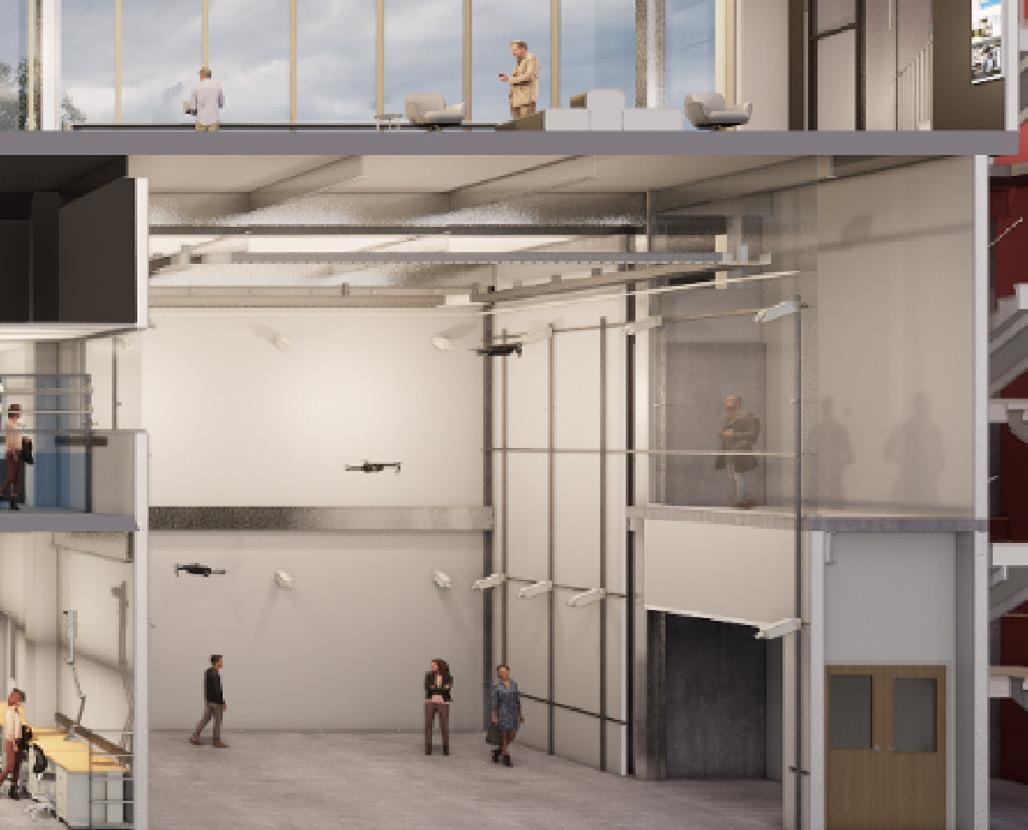



SOFTBOTICS: This lab is all about bringing robotics into everyday life. Tomorrow’s robots will be small, flexible, and designed to improve performance in our work, play, and health with electronics nested into soft, technologically advanced materials.
RAPID PROTOTYPING: A shared space fostering collaboration that hosts 3D printers, laser cutters, drill presses, and more.
DRONE ARENA: This twostory space will test cutting edge tech developed in the robotics lab including drones used for bridge inspection, flying robots, and legged robots.
MECHANICAL ENGINEERING 5
DRONES CAN NAVIGATE DYNAMIC ENVIRONMENTS
For drones to save lives in search and rescue missions, or even reliably deliver our packages they need to navigate dynamic environments without accident. Unmanned aerial vehicles (UAVs) have had success steering through open spaces time and time again, but the unpredictability of moving obstacles has been a challenge, especially in indoor environments with no GPS signals. Kenji Shimada, Professor of Mechanical Engineering, and his students leaned into this problem to develop new technology that enables autonomous flights in indoor dynamic environments.
The novel technologies, drone navigation and obstacle avoidance, and dynamic obstacle tracking and mapping, were put to the test last winter. Shimada’s drones were tasked with navigating an active Japanese tunnel construction site while avoiding collisions with moving human workers as part of a project sponsored by industry partners, Toprise Co., Ltd., and Obayashi Corporation.
“Companies have recognized that young people don’t want to do dangerous, physical work anymore so they are investing in robotics to fill the gap,” Shimada explained.
Shimada’s drones were able to measure the 3D geometry of the excavation front of the tunnel. This information, when compared to
design data, tells builders what parts of the tunnel are complete and what parts need to be scaled further, without putting people at risk.
“To our knowledge, this is the first time 3D scanning with an autonomous drone has been done in dynamic, under-construction tunnel environments,” said Zhefan Xu, the lead doctoral student of the drone project.
In order to predict the path of moving objects, like people at work in the tunnel, the team introduced the first real-time system that uses a 3D hybrid map to account for the static environment while simultaneously tracking dynamic obstacles. With this technology, the team refined their previous algorithm to account for the realtime planning required by in-motion drones to prevent collisions. The combination system allows the drones to approximate where a collision may occur and prevent it.


MECHANICAL ENGINEERING 6
MECH E inside: SCAIFE HALL
“To our knowledge, this is the first time 3D scanning with an autonomous drone has been done in dynamic, under-construction tunnel environments”
Zhefan Xu, Ph.D. candidate
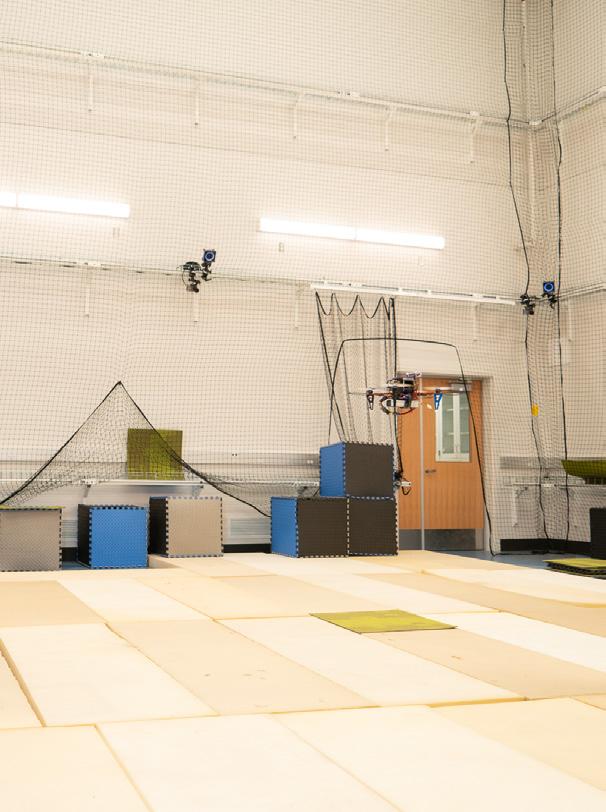
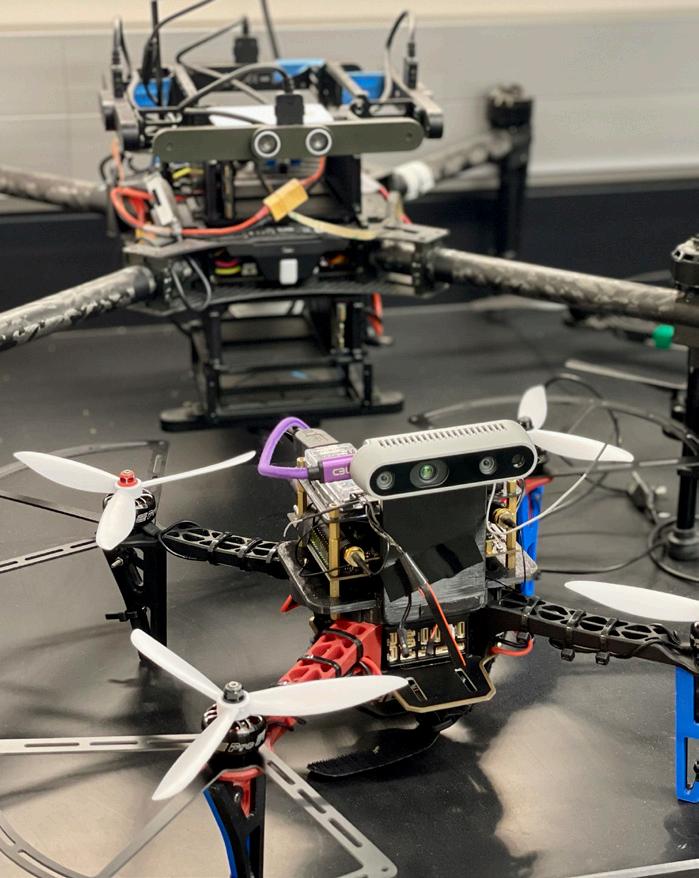
“The idea for this project stemmed from a scene in a sci-fi movie where a robot flew around inspecting an underground structure. After a decade of research on drones and three years on this project, I’m excited that we’ve made it a reality. I think that this technology will have a large impact on improving the safety of workers on construction sites,” said Shimada.
This research was presented at the 2023 International Conference on Robotics and Automation (ICRA) organized by the Institute of Electrical and Electronics Engineers (IEEE).
MECHANICAL ENGINEERING 7

MECHANICAL ENGINEERING 8 MECH E inside: SCAIFE HALL
NOW PRINTING: SEAWEED-BASED, BIODEGRADABLE ACTUATORS
Traditionally, soft robots have been made using synthetic polymers, rubbers, and plastics. Such materials provide soft robots with long operational lives and stable structures, but may pose risks to the environment if lost or damaged during use. Researchers seek to minimize this risk by creating new ways to build naturally decomposable robots.
An interdisciplinary team at Carnegie Mellon University, led by Victoria Webster-Wood and Adam Feinberg in collaboration with Carmel Majidi and Lining Yao, is developing new ways to fabricate biodegradable actuators for marine applications. Using a bio-ink made of materials sourced from common brown seaweeds, the research team identified designs and printing parameters that allow water-tight structures to be printed using the FRESH Printing method.
“We are very excited to expand the fabrication capability of the FRESH Printing method and optimize it for soft robotic applications,” explained Wenhuan Sun, MechE Ph.D. student. “The unique benefits of FRESH make it possible to create robotic structures with a combination of unusual properties.’’
Their approach, recently published in Advanced Functional Materials, allows small scale, very soft actuators that can extend, bend, and twist to be fabricated. They can also be combined into structures for gripping and positioning. The seaweed-based inks used by the research team rely on calcium to crosslink and form gels. This allowed the researchers to leverage the material properties in order to create actuators that can change shape and stiffness by varying the degree of crosslinking in the actuators.
“How do we balance the need for advanced soft robotic structures with the potential environmental impact that results from their creation? We believe that the biodegradable actuators printed using FRESH are a promising solution, and we are excited to continue making improvements!” said Ravesh Sukhnandan, MechE Ph.D. student.
The actuators’ capabilities don’t stop there. In addition to their robotic functionality, the actuators are fully biodegradable, degrading in natural ocean conditions within seven days. The actuators can also be safely consumed by marine organisms. This means that if lost or damaged during use, the actuators pose minimal risk to the environment.
Dr. Wenhuan Sun graduated in Fall 2023, but he has stayed in touch with the research team to help onboard and train the next generation of biodegradable robotics researchers. MS-BRIDGE Fellow Avery Williamson and GEM University Fellow Ravesh Sukhnandan have continued to develop the technology under the guidance of WebsterWood, Feinberg, Majidi, and Yao. They hope to further understand actuator performance in natural environments and extend this printing approach to complete robotic structures.
“We are thrilled to be able to continue this project where Wen left off,” said Williamson. “It’s incredibly exciting to be developing new tools and methods for technologies with clear sustainable applications.”

MECHANICAL ENGINEERING 9
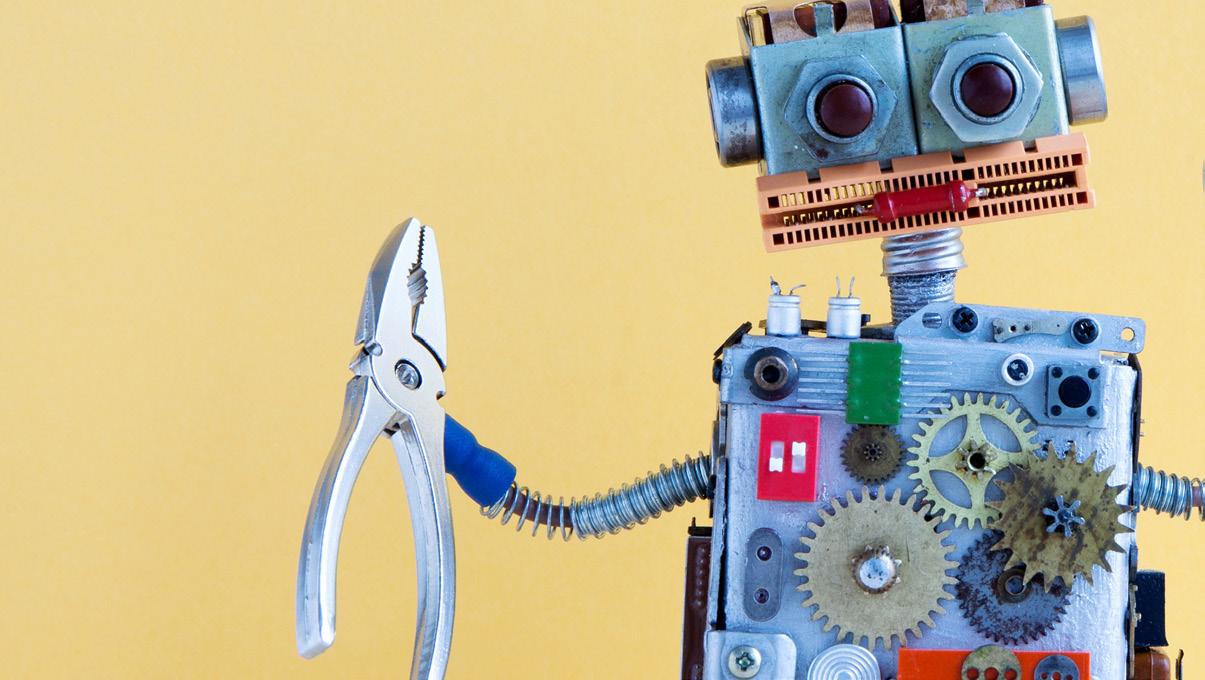
ROBOTOOL ENABLING CREATIVE TOOL USE IN ROBOTS
If an ingredient is out of reach on a high pantry shelf it wouldn’t take you more than a few seconds to find a step stool, or maybe even a chair, to stand on to bring the ingredient within your reach. What seems like a simple solution is the outcome of a complex problemsolving approach researchers call creative tool use. While using tools with its instruction is a useful skill, creative tool use is a much more advanced skill — making it a hallmark of advanced intelligence that beyond humans, few animals have mastered.
Researchers in Carnegie Mellon University’s Department of Mechanical Engineering in collaboration with Google DeepMind have posed the question, ‘Since humans understand creative tool use, can we teach robots how to use it too?’
“The fundamental challenge of creative tool usage is that it is by definition an ‘unknown unknown’ problem, meaning it is about learning, not creation. Therefore, we must bring in external knowledge to help the robots to brainstorm the large language models which extract all knowledge from the internet, are the perfect ingredients in this scheme,” said Ding Zhao, Associate Professor of Mechanical Engineering and the director of CMU Safe AI Lab.
To explore this idea, researchers developed RoboTool, a creative tool-use system built on large language models (LLMs) that accept natural language instructions about a robot’s environment including the size and positioning of objects in its workspace, and other embodiment-related constraints. RoboTool then outputs directly executable Python code as a plan to complete the task.
MECHANICAL ENGINEERING 10 MECH E inside: SCAIFE HALL
“This enables robots to do tasks that originally seemed impossible”
Peidi Huang, Ph.D. candidate

“As opposed to existing models that provide robots with concrete directions such as ‘use this fork to eat that cake,’ we only provide our robot with a high level objective like ‘eat the cake,’ explained Mengdi Xu, Ph.D. candidate.
RoboTool was put to the test when researchers asked two different robots to both perform three tasks requiring tool selection, sequential tool use, and tool manufacturing.
Tool selection was assessed by tasking a robotic arm to grab a milk carton out of its reach, and asking a four legged robot to move from one sofa to another — minding the gap in between. Both robots had to choose the most appropriate tool among multiple options to succeed. They demonstrated a broad understanding of object size, and shape as well as the ability to analyze the relationship between these properties and the ultimate objective to pass the test.
Sequential tool use required robots to use a series of tools in a specific order to reach the goal. The teams’ robots demonstrated this by moving blocks together
to climb a sofa, and using a stick to push a can onto a piece of paper to then pull the can within reach.
Tool manufacturing called for the robots to accomplish tasks by crafting tools from available materials, like using a kickboard and a pipe to create a lever to lift a cube. This test requires the robot to discern implicit connections among objects and assemble components through manipulation.
“This capability is important in robotics because it enables robots to do tasks that originally seemed impossible,” said Peide Huang, PhD candidate.
Moving forward, the team will incorporate vision models into the system to unlock an even stronger perception and reasoning capability. They are also looking to develop more interactive ways for humans to to participate in and guide robots’ creative tool use.

MECHANICAL ENGINEERING 11
SPINAL CORD STIMULATION OFFERS NEW HOPE FOR PEOPLE LIVING WITH PARALYSIS AFTER STROKE
Globally, every fourth adult over the age of 25 will suffer a stroke in their lifetime, and 75% of those people will have lasting deficits in fine motor control. Until now, no treatments have been effective for treating paralysis in the so-called chronic stage which begins six months after the stroke. Technology developed by Douglas Weber, Professor of Mechanical Engineering, in collaboration with the University of Pittsburgh is offering new hope for people living with impairments that would otherwise be considered permanent. The team discovered that muscles respond directly to electrical stimulation of specific spinal cord regions enabling patients to regain mobility of their arm and hand.
Spinal cord stimulation technology uses a set of electrodes placed on the surface of the spinal cord to deliver pulses of electricity that activate nerve cells inside the spinal cord. Research groups around the world have shown that this stimulation can be used to restore movement to the legs but the complexity of the neural signals controlling the unique dexterity of the human hand and arm adds a significantly higher set of challenges.
By engaging intact neural circuits located below the lesion, a pair of thin metal electrodes resembling strands of spaghetti implanted along the neck allow stroke patients to fully open and close their fist, lift their arm above their head or use a fork and a knife to cut a piece of steak for the first time in years.
“The sensory nerves from the arm and hand send signals to motor neurons in the spinal cord that control the muscles of the limb,” explained Weber. “By stimulating these sensory nerves we can amplify the activity of muscles that have been weakened by stroke. Importantly, the effect only strengthens muscle activation when the patients are trying to move, providing assistance only as needed so the patient retains full control of their movement.”
Nikhil Verma, a doctoral student in Weber’s lab, has been monitoring muscle activity to have a direct measure of the effects of stimulation on the spinal cord.

MECHANICAL ENGINEERING 12 MECH E inside: SCAIFE HALL

“To make this an effective therapy, we need to develop a robust method for controlling the pattern and timing of electrical stimulation applied to the spinal cord,” said Verma. “By measuring activation levels of muscles, we can detect when the patient is trying to move and then deliver targeted stimulation to assist the movement.”
Verma’s research used electromyography (EMG) sensors to measure the effects of stimulation on muscle recruitment and to detect movement intentions, generating a control signal for patterning spinal stimulation to facilitate the intended movement.

Early clinical trial results hint at a promising future of spinal cord stimulation as a neurorehabilitation strategy for a sizeable proportion of stroke survivors: unexpectedly, the effects of stimulation seem to be longer-lasting than scientists originally thought and persist even after the device was removed, suggesting it could be used both as an assistive and a restorative method for upper limb recovery.
“A key to this success is the rich combination of engineering and neural science efforts with the input of the clinical team,” explained Weber. “In Pittsburgh, we work unselfishly at the intersection of science, engineering, and medicine to make practical solutions that won’t take decades to bring to medical practice.”
Moving forward, researchers continue to enroll additional trial participants to understand how many stroke patients can benefit from this therapy and how to optimize stimulation protocols for different severity levels.
“Thanks to years of preclinical research building up to this point, we have developed a practical, easy to use stimulation protocol that could be easily translated to the hospital. Especially since we can use and adapt existing FDA approved clinical technologies,” said Marco Capogrocco, Assistant Professor of Neurological Surgery at the University of Pittsburgh.
This research was supported by the Department of Mechanical Engineering and the Neuroscience Institute at Carnegie Mellon University, and the Department of Neurological Surgery and the Department of Physical Medicine and Rehabilitation at the University of Pittsburgh. It was originally published in Nature Medicine.
MECHANICAL ENGINEERING 13
BOLD INITIATIVE TO MAKE HOCKEY SAFER RETURNS FOR SIXTH YEAR

CMU students strive to make ice hockey safer for players regularly blocking 100 mph shots.
For the sixth year in a row, Carnegie Mellon University’s College of Engineering joined forces with The Pittsburgh Penguins, Covestro, and Bauer Hockey to make ice hockey safer. The annual make-a-thon, “Rethink the Rink” offers students the opportunity to lend their brainpower and creativity to innovating new technology in the sport.
This year students developed shot blocker equipment to protect players’ lower legs and ankles from opposing teams’ shots. Despite how often injuries occur when players use their skates to deflect the puck, there is no standard shot blocker equipment.
Over the course of a week, CMU Engineering students developed and tested basic
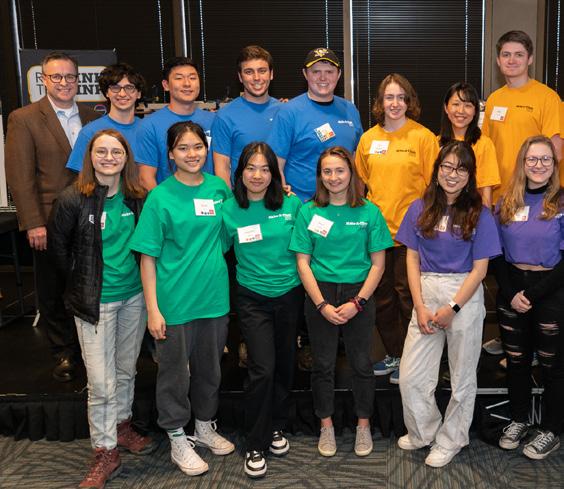
prototypes in TechSpark, the school’s makerspace, with input from hockey professionals from the Pittsburgh Penguins and materials experts from Covestro. Their challenge was to uncover material solutions that strengthen player protection without inhibiting performance.
At the end of the week teams presented their prototypes to a panel of expert judges from the Penguins, Covestro, Bauer Hockey, and the College of Engineering. Each team was recognized for their accomplishments.
“What [the students] have accomplished, in terms of understanding
the problems we face with our players, and coming up with four very different, but four very innovative products is pretty incredible,” said Kevin Acklin, President of Business Operations or the Pittsburgh Penguins.
“Working with the materials experts at Covestro and the Pittsburgh Penguins is truly a rewarding experience for our students,” emphasized Bill Sanders, Dean of the College of Engineering.
The first Rethink the Rink in 2018 focused on redesigning dasher boards. Segments of the students’ designs have since been installed at the
MECH E STUDENT STORIES
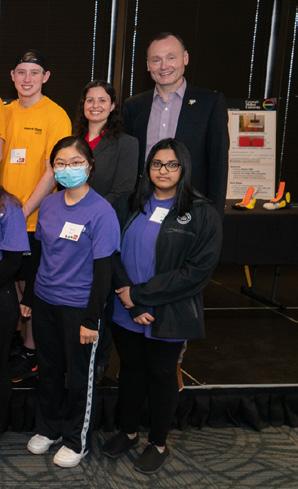
Pens practice facility. Other past projects include goalie helmets, glass and dasher board intersections, and protective padding.

STUDENT ACCOLADES

Best Prototype 2023 Tech Spark Design Expo
Automatic Kindling Machine automates the process of generating kindling for outdoor fire pits or indoor fireplaces. The user inserts a large piece of wood, the machine applies many small impacts to wedge it over the splitter, and then a single large impact splits the wood into smaller pieces.
Zach Martens, Elijah Sech, Ian Turner, Casey Walker

David Guirguis named a top Innovator Under 35 by MIT Technology Review Arabaia for work on artificial intelligence tools to make 3D printing metals more time and cost-effective.

Alexius Lyle Wadell was named a META research fellow. Fellows are presented with numerous opportunities to engage with Meta researchers, enabling them to gain further insight into industry research and highlight their research.

Owen Pearl has won the American Society of Biomechanics
Predoctoral Award — the most prestigious award in the field of biomechanics for doctoral students.
MECHANICAL ENGINEERING 15
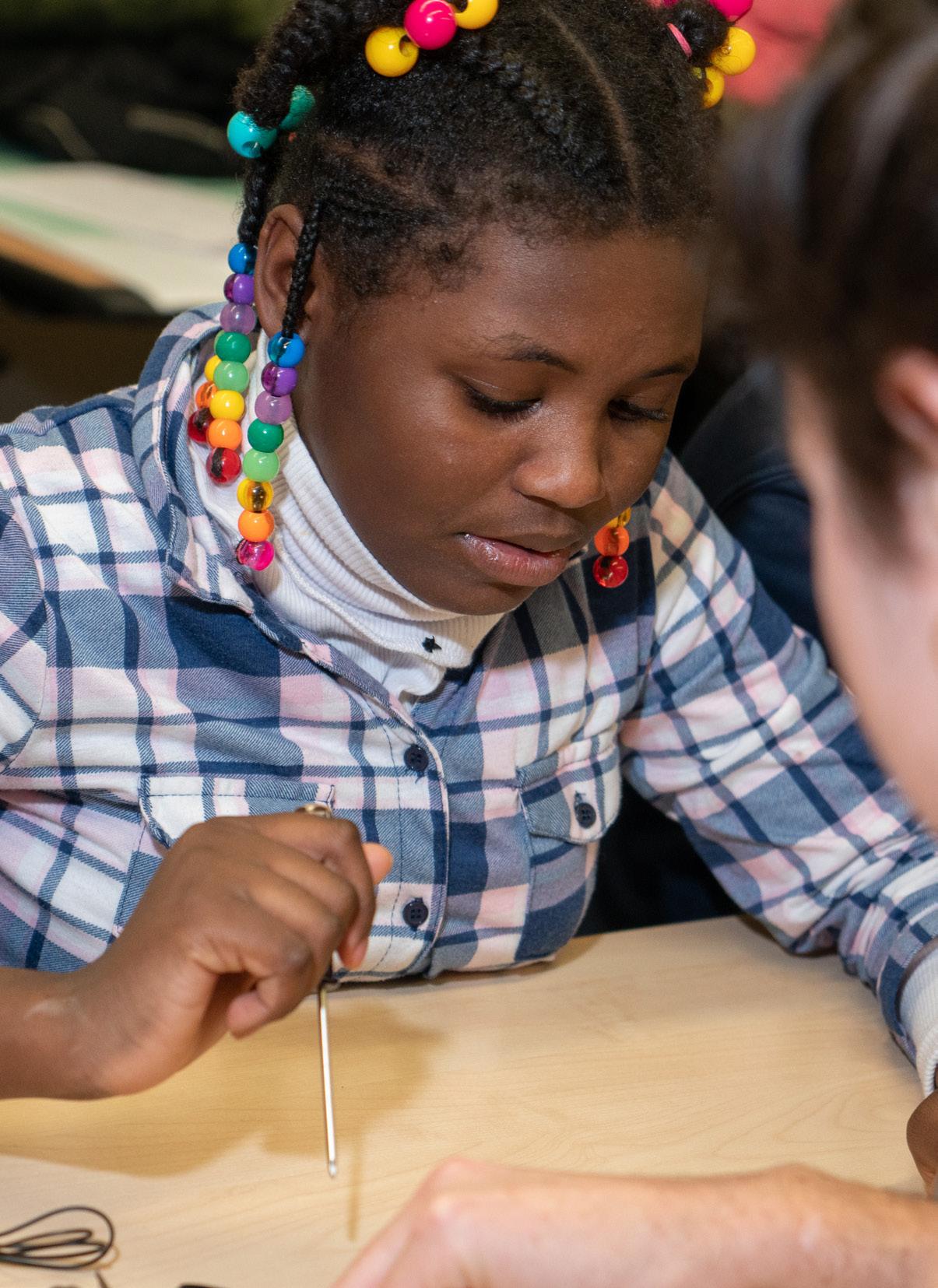
GWEN’S GIRLS
PARTNERSHIP FOSTERS
CHILDREN’S INTEREST IN ROBOMECHANICS
STUDENT STORIES
When James Zhu, a doctoral student in Aaron Johnson’s Robomechanics Lab, began studying with the Department of Mechanical Engineering at CMU he made it a personal goal to engage the broader Pittsburgh community with his research. Driven by his passion, Zhu has introduced roughly 100 grade school girls and counting to engineering design and robotics through the STEM Initiative at Gwen’s Girls, a non-profit organization committed to empowering girls and young women to have productive lives through holistic, gender-specific programs, education and experiences.
In the spring of 2021, Zhu and roughly 10 other students in Johnson’s lab kickstarted their outreach program with a virtual-friendly curriculum. For 90 minutes every week for four weeks, Gwen’s Girls participants aged 8-12 learned how to bring their imagination to life through Computer-Aided Design (CAD) software.
After learning how to model complicated shapes in TinkerCAD, a free web app for 3D design, the girls were posed with a design challenge. How can they use the engineering design process to craft vehicles of the future? Each participant modeled their own design ideas, everything from a rocketship to a flying car, that were then 3D printed on CMU’s campus and mailed to each girls’ home.
The program was so well-received by the students that Gwen’s Girls invested in 3D printers for their Northside location.
“We loved that with this partnership, the CMU students were willing to not just enhance what the girls were doing and their STEM experience, but they helped us to build our internal capacity to continue to provide that programming,” explained Merridith Murray who oversees academic programming at Gwen’s Girls. She shared that Zhu’s team trained Gwen’s Girls facilitators on how to use the CAD software and 3D printers. “Oftentimes outside providers come in with a one time experience, and students aren’t becoming engineers from one enrichment activity. We need ongoing programming to foster that, and CMU has helped us to sustain a STEM experience for our girls.”
More recently, Zhu hoped to bring a more handson experience to the participants so they retooled the program and introduced MiniRHex, a low cost hexapod robot. MiniRHex is a smaller version of the types of legged robots Zhu and his colleagues in the Robomechanics Lab use in their research.
“As engineers we often seek inspiration from nature, like how a mountain goat scales cliffs or humans navigate city sidewalks,” said Zhu. “This robot was bioinspired by cockroaches and mimics one with its alternating tripod legs.”
In this new program, students are introduced to the scientific method as they try to adjust the legs on the robot to make it run and jump effectively. They are given the choice between various leg-types and must figure out which ones work best to achieve desired movements.
“Since we have created a recurring program, we can foster our lessons to what the girls are most interested in and meet them at their level of understanding. Because of this we get to see the ‘aha’ moment in so many kids when they understand the mechanics behind their robot.”
Lundyn West, a fifth-grader participant in the program was able to build off what she was learning in school through the lab. “It’s really cool seeing how the brains of the robot make it all actually work! We learned about how the legs have to be timed right with the electrical connection to make the robot move.”
While the robots used in the Gwen’s Girls program are designed specifically for teaching and outreach programs, RHex robots, on a larger scale, are used to explore different types of terrain. This development enables researchers to send robots into environments not necessarily safe for human exploration like contaminated waste areas or old mines.
“By using the MiniRHex platform, we can connect what the students are using in this program to the research we are doing in the lab. This lets them see a path towards becoming engineers and researchers,” added Johnson.
Zhu plans to continue building this program and educating facilitators on how to share it with Gwen’s Girls locations across Pittsburgh.
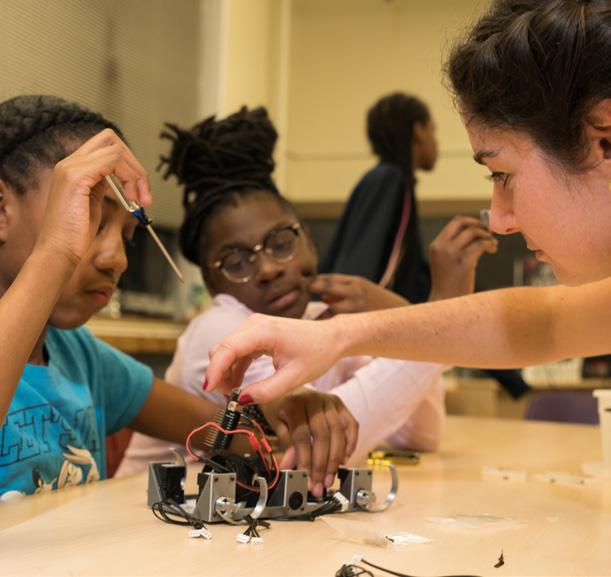
MECHANICAL ENGINEERING 17
ENGINEERING STUDENTS APPLY MECHANICS TO FOOD
Carnegie Mellon University engineering students were back in the kitchen this semester to learn how the same mechanics that apply to airplanes and automobiles relate to the mechanics of cells in the foods we eat.
The popular course focuses on how controlled mechanics such as cutting, chopping, and mixing can alter the texture, taste, consistency, and nutritional value of foods. During hands-on labs and visits to restaurant kitchens, students also saw how mechanical tools such as a knife or mortar and pestle are used in food preparation. Philip LeDuc, a professor of mechanical engineering, says that while there are numerous kitchen chemistry courses, he doesn’t know of any other food related courses that focus mainly on the study of mechanics.
The class spent time with Chefs Kate Lasky and Tomasz Skowronski, who were finalists for the James Beard Best Chef: Mid-Atlantic Award, and their Bloomfield restaurant, Apteka, was also included in the New York Times list of 50 best restaurants in America for 2022.
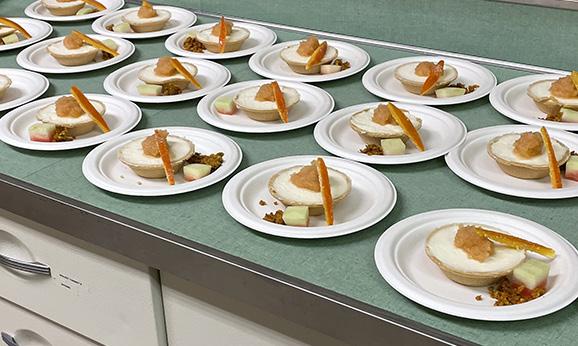
Lasky and Skowronski’s commitment to nearly continuous menu experimentation and creative use of local and seasonal ingredients contributes to their success, but it also served to capture the attention and imagination of the students whose engineering studies also call upon their ability to experiment, employ innovative methods, and develop creative use of varied materials.
But the connection didn’t end there. Skowronski is a Carnegie Mellon alumnus with a degree in philosophy, and his father, Marek Skowronski, is a material science and engineering professor, who joins his son on expeditions to glean seasonal fruits, vegetables, and sunflowers.
In what Pittsburgh Magazine called, “the most striking, of-the-moment (and, well, very Instagramable) plant-based dish around,” Skowronski added a whole-roasted sunflower head to Apteka’s menu that diners ate like corn on the cob.
“For two years we tried to capture the sunflowers when the seeds were just right and in the third year, we did it and were able to serve them when the seeds were not too fibrous and could be eaten with out having to spit out the shells,” explained Skowronski, who ate sunflower seeds from the flower heads as a boy visiting Poland.
The mechanical principles that students learn throughout the semester prepare them for the final class project to create a new food. Past capstone projects have included an on-the-go pancake that used the mechanical properties of spherification to encapsulate
MECHANICAL ENGINEERING 18
E STUDENT STORIES
MECH
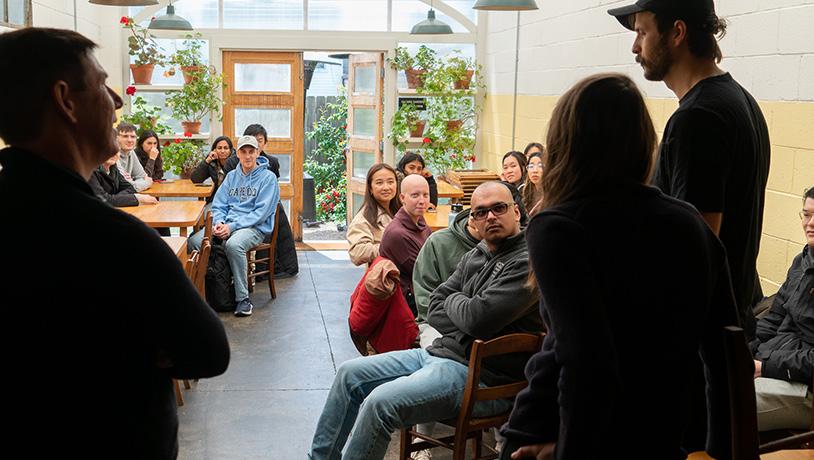
syrup inside the pancake bites; stainedglass potato chips that were made colorful and translucent by boiling, molding, and dyeing; and taffy balloons that were created by modifying taffy with gelatin and adding helium.
This year’s projects were equally creative and included chocolate that was colored, garnished, and tempered to look like tortilla chips, bubble tea with tiny bubbles made of tea instead of tapioca, s’moremallows, made by encapsulating chocolate and graham crackers in marshmallow fluff, and junk jam, which was a creative use of food waste made by blending, boiling, and sweetening the otherwise inedible rind of a watermelon.
LeDuc says it’s one of the most creative courses because instead of having only a limited number of materials to work with, students can use anything edible.
“It’s a real shift from the best project being done by the students who are the most knowledgeable or have access to the best materials to the ones who are most creative,” said LeDuc.
Ten years ago, when Kurt Willwock, a Heinz company scientist, reached out to LeDuc to talk about ketchup, LeDuc’s initial reaction was, “I don’t do food.”
But it turns out LeDuc, who studies cell mechanics in human disease, did have the information and expertise that Willwock wanted. Much of LeDuc’s work envisions cells and molecules as systems that can be investigated with some of the same fundamental approaches used on machines.
Those same mechanics can also be applied to the cellular composition of food like ketchup, which according to Willwock is one of the most scientifically investigated foods in the world. It’s a revelation that LeDuc has been sharing in the Culinary Mechanics course he has been teaching ever since. He estimates that close to 150 students have taken the course, including Jiaxuan (Josh) Li who graduated in 2019 with degrees in mechanical engineering and robotics and is now a product manager with the molecular beverage startup company, Cana. Li said of the culinary mechanics class, “It really inspired me and helped affirm my passion in the food space.”
“It’s a real shift from the best project being done by the students who are the most knowledgeable or have access to the best materials to the ones who are most creative.”
Philip LeDuc, Professor, Mechanical Engineering
MECHANICAL ENGINEERING 19
D f AI: THE MISSING PIECE OF ARTIFICIAL INTELLIGENCE ENGINEERING
Considering how quickly engineering design and manufacturing have advanced alongside computational developments, it may surprise you that very few engineers are trained in both engineering system design and artificial intelligence. There are countless opportunities for breakthrough improvements in how we develop new technology using AI in engineering design, but to succeed in these challenging areas, engineers must understand a new specialty: design for artificial intelligence.
Chris McComb and Glen Williams have developed a Design for Artificial Intelligence (DfAI) framework in collaboration with researchers at Penn State University to educate and encourage the academic and industrial engineering community to adopt AI engineering design.
“Most of the time, we view AI as a tool to add onto an existing system, but to develop better systems we need to integrate AI into the engineering design process from the very beginning,” explained McComb, an associate professor of mechanical engineering.
A core challenge is motivating institutions to make investments in the long-term potential of AI technologies. Since engineering is product-driven and the incentives in design and manufacturing prioritize short-term excellence, budgeting resources for long-term research and development is challenging but worthwhile.
Williams, previously McComb’s student and now principal scientist at Re:Build Manufacturing, illustrated the importance by describing two hypothetical companies mass-manufacturing electric aircrafts. For up-front development, Company A chooses a manual manufacturing path to quickly hit the market and reach profitability. On the other hand, Company B, builds a data-rich process that captures intelligence throughout the lifecycle of the design. Within the next 10 years, Company B is able to drastically reduce their operating cost by utilizing data-driven design that can both
optimize the production of their aircrafts and create better products. Company A can no longer keep up.
Because design and manufacturing don’t happen in silos, DfAI applies to the broader aspects of the engineering design process. Williams suggests that foundationally, advancing DfAI can be addressed through 1) raising AI literacy in industry, 2) redesigning engineering systems to better integrate with AI, and 3) enhancing the engineering AI development process.
“Engineering data is complex and not always relatable to the wider community,” McComb explains as one reason other fields may be innovating AI technology quicker. “The number of experts able to interpret this data is small, so DfAI will require individuals to have specific expertise. Academia and industry need to work together to support long-term innovation in this area.”
The team outlines three personas as necessities for DfAI: engineering designers, design repository curators, and AI developers. An engineering designer may be a person or team responsible for developing the specifications of a new project. They are the problem solvers who can understand the engineering constraints, as well as the AI algorithms. Design repository curators must take the role of a database maintainer one step further by having engineering design and manufacturing knowledge to deliver design engineers the data management tools to meet workflow demands and be extensible to future demands. Finally, the AI developers must be able to ideate, develop, market, and continuously improve AI software products to help the design engineers.
“We can’t think of AI development as an afterthought in our core operations,” McComb summarizes. “Unless we augment design engineers with next-generation design and manufacturing software based on deeply-integrated AI, our ability to design novel and useful technology will fall short of the potential of these new manufacturing techniques.”
MECHANICAL ENGINEERING 20
MECH E AI ENGINEERING

Per Williams, several industries may have an easier time adopting DfAI principles. Computer science applications, such as products manufactured by digitallydriven techniques like additive manufacturing, naturally have a complex cyber-physical pathway and yield personnel that would be well-suited in adopting and driving DfAI principles. Regulated industries, such as aerospace and medical devices, are accustomed to following rigorous procedures and reliable data storage techniques in the context of very complex engineered systems, so they likely have the resources to begin the DfAI adoption process. We may also see the internet of things (IoT) and smart device product designers adopting DfAI principles sooner rather than later. These designers stand to benefit not only from data during the design process, but also from vast amounts of data gathered from their devices in testing or in practice. Harnessing this valuable product data from the field could result in tremendous benefits to AI tools that help enhance the quality, performance, sustainability, and profitability of future products.
“Since there is so much variety between engineering applications, industries, technologies, and scales of operation, establishing general frameworks, common terminology, and written principles is vital to growing an interconnected community of AI Engineers who can collaborate together,” Williams elaborated. “Our DfAI framework provides the high-level starting point for these critical discussions.”
“To develop better systems, we need to integrate AI into the engineering design process from the very beginning.”
Chris McComb, Associate Professor, Mechanical Engineering
MECHANICAL ENGINEERING 21

MECH E AI ENGINEERING
IMPROVING FOOD PREP WITH THE POWER OF AI

Imagine that dinner could be prepared by a robot in your own home with just the push of a button. It sounds like something straight out of a farflung future. Now, researchers at CMU are laying the groundwork for this technology with artificial intelligence.
Alison Bartch, Atharva Dikshit, and Abraham George, under the guidance of Amir Barati Farimani, an assistant professor of mechanical engineering, trained a robot arm on different fruit slices and shapes to help improve its accuracy with cutting and moving real pieces of food on a cutting board.
“So I’m cooking and have a cluttered cutting board. I’m reasoning about how to chop and how to select the objects that I want to cut, without cutting things that I don’t want,” said Bartch, a Ph.D. candidate in mechanical engineering. “It’s something that humans are pretty good at. And it’s a surprisingly difficult problem for robots.”
The researchers combined two vision foundational models — models trained on large visual data sets — to help the robot arm recognize the shape and the type of fruit and vegetable slices. The AI would then determine what motion to use on these slices to produce the correct results with 70% accuracy.
One of the models was only trained on whole fruits and vegetables, so the researchers needed to finetune the AI to more accurately recognize slices with a relatively small amount of newly collected data. According to Bartch, their fine-tuned framework can potentially be used for other related research; the combined foundational models, however, can be used for a variety of other AI projects in the future.
“That’s just one of the things in a lot of robotics and machine learning — a lot of the data sets are already collected,” said George, also a Ph.D. candidate in mechanical engineering. Bartch said that the research focuses more on the “practicalities” of cutting food,
such as producing the correct number of slices and moving pieces out of the way, making this research more applicable to a real kitchen than other research.
“For this work, we focused more on the pipeline surrounding it, as opposed to the actual chop action,” Bartch said. “You want to pick which object to cut. You want to clear the scene before you cut. After you cut, detecting where the objects are then and continuing to plan. A lot of existing work focused on cutting assumed the position of the vegetable and that there is nothing else in the environment.”
However, it will still be a while before AI will be chopping vegetables in homes. According to Bartch, there is still a lot of research and fine-tuning needed, and their robot still needs some human input. It’s difficult to replicate human reasoning in machines, even with tasks many humans find simple.
“I think there is definitely a really long way to go before it’s in a person’s house.” Bartch said. “Because reasoning about cooking is really difficult. When you want to go into more practical situations, you need the system to be able to reason when the food is done.”
Atharva Dikshit, a master’s student in mechanical engineering, also contributed to this research. This research was submitted to the Journal of Intelligent and Robotic Systems.

MECHANICAL ENGINEERING 23
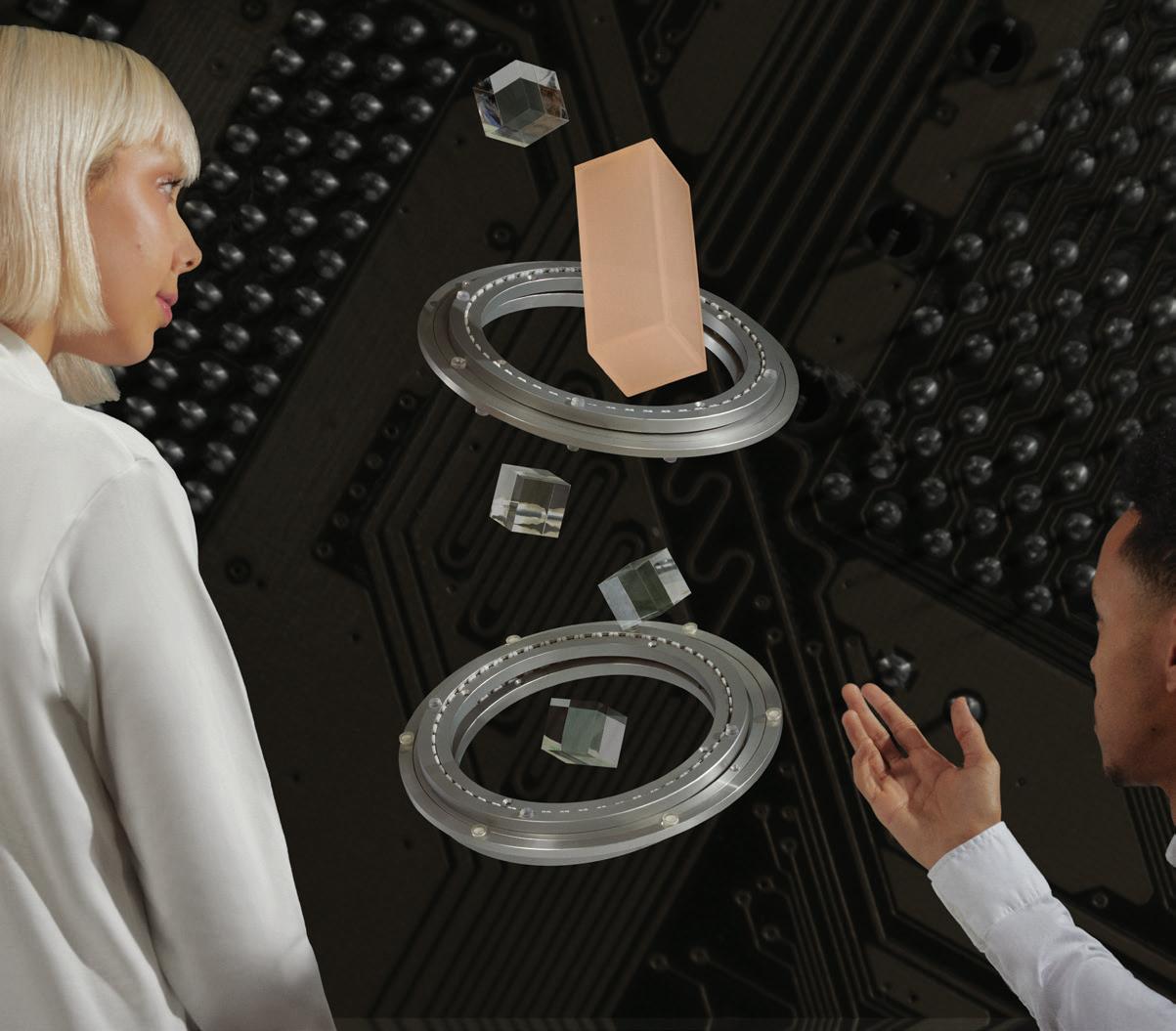
NEW ONLINE CERTIFICATE
ACCESSIBLE AI ENGINEERING
The Department of Mechanical Engineering at Carnegie Mellon University is making it easy for practicing engineers to solve industry problems with a data-driven, AI approach.
A new online graduate certificate — AI Engineering Fundamentals - Mechanical Engineering — makes CMU’s AI expertise accessible to working professionals anywhere in the world.
“We have heard from a lot of people in industry looking to learn about and gain a skill set in AI/ ML from the experts,” said Jon Cagan, Head of the Department of Mechanical Engineering. “We are leading mechanical engineering in AI/ML fundamentals and applications and thanks to this certificate we can share our world-class courses and instructors with practicing engineers.”
Students enrolled in the certificate will take two graduate-level courses; Machine Learning and Artificial Intelligence for Engineers, and Deep Learning for Engineers. The program takes one year to complete with one 90 minute course per week and optional recitation sessions.
Coursework will focus on analyzing practical engineering problems, so students can directly apply machine learning concepts to their careers—and become more efficient, innovative, and successful in their approach and in the solutions they create.
For more information and to enroll, visit cmu.edu/online/aimlmeche.

ALUMNI NEWS



Alexander Baikovitz was recognized in @PghBizTimes 30 under 30 list. His company Mach9, is working to deploy its robots to cities nationwide to improve accuracy surveying infrastructure such as gas and water lines.
Dr. Jimmy Kenyon was named the Director of @NASAglenn. Along with overseeing the center he will be conducting revolutionary aeronautics research to make sustainable commercial aviation a reality.
Shashank Sripad was named Forbes 30 Under 30 in Energy. His research on electric mobility has made him a go-to voice for sanity checking advancements in battery technology, informing public policy on autonomous electric vehicles, and he was highlighted by Bill Gates in his book on climate change. He recently founded a company in stealth to build batteries for electric aircraft with the support of an $11.9 million ARPA-E grant.

Francine Leung was awarded a Fulbright Award to pursue her Ph.D. in sports biomechanics in England.
We want to hear from you! Email your news to me-alumni@andrew.cmu.edu
MECHANICAL ENGINEERING 25 MECH E ALUMNI
INNOVATING THE TRADING CARD INDUSTRY
The trading card industry is thriving, and cards are selling for record-setting prices. In August 2022, a 1952 Mickey Mantle card sold for a whopping $12.6 million, while in 2021, a Pikachu Pokémon card reaped $5.275 million. Along with high sales prices for individual cards, as of 2019, the trading card industry was valued at $4.7 billion, and it’s projected to reach a value of $62 billion by 2027. Despite the soaring projections, the technology serving the industry hasn’t kept pace.
Trading cards are historically sold and traded at local, independently owned stores. With small staffs and millions of cards to sort and catalog, these businesses struggle to run efficiently and profitably. With e-commerce creating an increasingly competitive business environment, business owners are faced with a dilemma of how they can stay afloat with their limited capabilities.
Carnegie Mellon University alumni, Kevin Lipkin (MechE’08, TPR’09) and Cornell Wright (ECE’07, CS‘08), believe they have the answer with the Roca Sorter, a trading card sorting and cataloging robot.
Serial entrepreneurs, Lipkin and Wright spent 15 years founding and growing companies within the healthcare, wastewater, education, and agricultural industries. While they had little background knowledge, they began their foray into the trading card industry in late 2019 after meeting with some early customers of the Roca Sorter.
“We could just hear and see what a game changer the product was for them, helping these small businesses grow, be more efficient, and really do things that they otherwise wouldn’t be able to,” said Lipkin.
They recognized an opportunity with the product and moved forward with acquiring the Roca Sorter product line to further commercialize the technology.
The Roca Sorter works in a two-fold process by first identifying a card and then sorting it. The input tray of the machine is loaded with 1,000 cards at a time. Then, a camera takes an image of a card, which is analyzed via an image-hashing algorithm and compared to the cards of a known “universe,” i.e., “Magic the Gathering” or “Pokémon.” Once the card is identified and mapped with textual information, it’s sorted using a mechanical process. The top card in the input tray is picked up with a vacuum pickup cylinder which moves along an X/Y gantry to lay the card in one of 45 bins in the machine. Then, the second card in the input tray is compared to the first card that was analyzed and placed in a bin. This process continues until the machine has placed all 1,000 cards into a bin. The machine then recompiles the cards and places them back into the input tray in the order that the customer wants. Typically, customers ask for the cards to be sorted alphabetically or by market price.
The customer is also sent a CSV file of all the cards that were sorted by the machine, thus allowing the customer to build a “library” of their inventory. This CSV file can easily be loaded into an ecommerce inventory account. Customers, who may sell thousands of cards per day, can list their cards for sale online without having to individually go through their bulk collections. Lipkin explains, “By having the cards cataloged and alphabetized, it’s like the
MECHANICAL ENGINEERING 26
MECH E ALUMNI
“We could see what a game changer the product was... helping small businesses do things that they otherwise wouldn’t be able to.”
Kevin Lipkin (MechE’08, TPR’09)
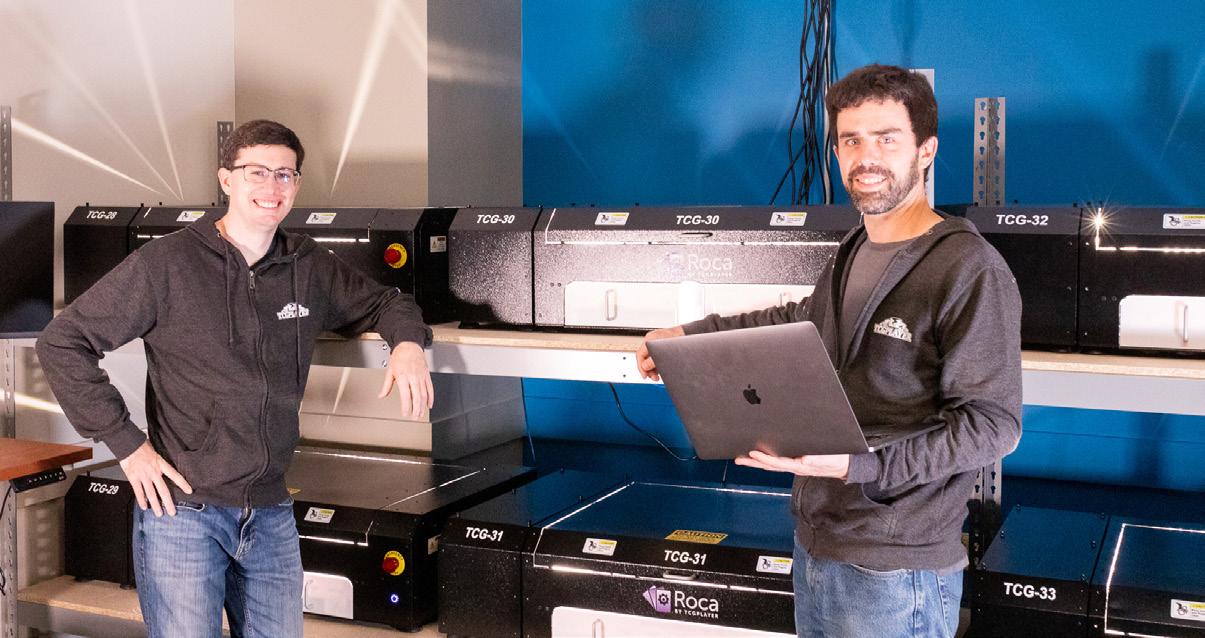
Dewey Decimal System. It becomes very easy and much faster to pull the exact cards that got ordered that day and get them shipped out.”
Once Lipkin and Wright acquired the Roca Sorter, they had to support existing customers and set up new warehousing and manufacturing facilities for the robots.
“The initial focus was ‘How do we keep selling these and have a product that makes our customers happy and be able to support them?’” said Wright. Driven by this ideology, Wright and Lipkin worked on the Roca Sorter and its software to improve reliability and manufacturability. They’ve also implemented a support plan for their customers, which provides replacement parts and software updates.
Since 2019, Lipkin and Wright have sold upwards of 200 machines and have grown to a nine-person team. They
were acquired by TCGplayer in November 2021, which allowed them to continue making improvements on their product and grow. In 2022, their robots sorted more than 100 million trading cards across their customers, many of whom run their machines 24/7. Late in 2022, eBay acquired TCGplayer, making Roca Sorter part of an 11,000-person company. Lipkin said of the acquisition, “I think this is a pretty unique opportunity to take everything we’ve done to the next level.”

STORIES
ALUMNI

THE HUMAN ELEMENT: MECHE ALUMNUS FORGES SUCCESS BY PUTTING PEOPLE FIRST
Growing up in a mill town south of Pittsburgh, Bruce Smith (MechE‘85) was all too familiar with the impact factory closures could have on an entire community.
“Seeing not only the financial impact, but the emotional toll unemployment took on these men and women made me recognize that my classmates and I might actually be equipped to help,” Smith says.
During Smith’s senior year at Carnegie Mellon, he was connected with a group of unionized workers who were impacted by the closure of an Oscar Meyer plant near Pittsburgh. The displaced workers were looking to start their own business and turned to the Mechanical Engineering Department for help.
“I will never forget my classmates rallying around those folks to make a difference. For many of us, it was our first exposure to a factory floor. It was the first time I really got to see how things are made.” Because of that project, and the passion of the men and women to bring back jobs for themselves and for their community, Smith’s career mantra around putting people first was bolstered in an unforgettable way.
Today, Smith is the Owner, Chairman, and CEO of Detroit Manufacturing Systems (DMS), a certified Minority Business Enterprise that builds over 1.5 million large-scale products per year and employs roughly 1,500 people, primarily from underserved areas.
MECHANICAL ENGINEERING 28
MECH E ALUMNI
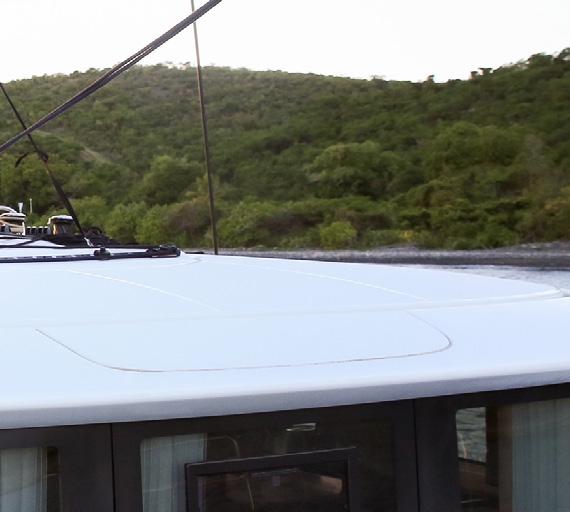

Smith thoroughly enjoys working with his teams to implement technology to help processes on the floor. “I love working on anything and everything that fundamentally improves the business and helps us better serve our customers,” he explains.
His favorite part is helping enrich the lives of others, “I’m enthusiastic about building up our employees personally and professionally and watching them light up in response,” said Smith.
Under Smith’s leadership, DMS has built an inclusive and empowering culture where employees are encouraged to be the boldest versions of themselves and have fun in the process.
“A casual observer might not understand the value of our playful nature, but our fun events, like our bocce ball and cornhole tournaments, are about getting our teammates to see each other as people,” explains Smith. “We aim to tear down walls and build bridges with each other to establish trust. This trust allows us to be better team players who make better decisions and ultimately better products for our clients.”
Along these lines, DMS separates employees into sixteen houses, much like those in the Harry Potter novels. Houses are comprised of salaried employees that are put together cross-functionally and given an annual budget to support a local charity of their choice, both financially and through volunteer hours.
Simultaneous to giving back to the community, Smith and DMS are committed to doing better for employees. DMS boasts an impressive internal promotion rate (one in three employees have been promoted in the last 10 years). The company also funds a tuition program that pays upfront for employees to pursue further education in any discipline they chose to better themselves.
Smith emphasizes, “We really want to change the world one person at a time, which aligns with our core values of serving others, enriching lives, rising together, and giving back. These elements work in harmony to create an ecosystem where people work together and help one another.”
Smith credits CMU for lifting him up and ingraining the mindset that bringing the community together is pivotal to solving real world problems. To give back to CMU, Smith has made a gift to the Mechanical Engineering Department in support of a new initiative focused on developing activities within the undergraduate curriculum that center on societal challenges from energy and climate change to drought and disaster relief.
“The best engineers I have ever met understood that everything they do, they do for and with people. Engineers that launch their ideas without taking the time to get feedback from others don’t do as well. They are missing how important the human element is to their success.”
To the next generation of engineers, Smith says, “Have fun, make the world a better place, and help as many people up with you as you can.”
MECHANICAL ENGINEERING 29
FACULTY AWARDS & HONORS


Rebecca Taylor became the inaugural ANSYS Career Development Chair in Engineering. This professorship is a recognition of Bex’s outstanding scholarly achievements.
Jessica Zhang was named a 2023 SIAM Fellow for pioneering contributions to computational geometry, volumetric parameterization, isogeometric analysis, mesh generation, image processing, and simulation-based engineering applications.



Burak Ozdoganlar was inducted into the 2023 Class of AIMBE College of Fellows. He was recognized for his contributions bridging biomedical engineering, scalable manufacturing, and mechanical design and analysis.


Chris McComb was awarded the ASME Journal of Mechanical Design 2022 Guest Associate Editor Award. Jon Cagan was the keynote speaker at the Mechanical Engineering Education Summit — the only conference specifically for MechE department heads addressing issues affecting engineering education.

Victoria Webster-Wood and Jon Malen both received Multidisciplinary University Research Initiative (MURI) grants from the Department of Defense.
Sarah Bergbreiter graduated from the ELATES at Drexel Leaders Program, a national leadership development program designed to promote senior women faculty, and faculty allies of all genders, in STEM fields.
RECIPIENTS OF THE ENGINEERING DEAN’S EARLY CAREER FELLOWSHIP

Assistant Professor
Victoria Webster-Wood

Assistant Professor
Ding Zhao
MECHANICAL ENGINEERING 30
MECH E FACULTY

FACULTY IN THE NEWS






Carmel Majidi talked with Science Friday about his breakthrough in softbotics: a new material with metal-like conductivity and self-healing properties that, for the first time, can support power-hungry devices.
Spinal cord stimulation technology developed by Doug Weber in collaboration with the University of Pittsburgh was featured in the New York Times for its life-changing impact on people disabled by strokes.
Albert Presto’s mobile lab sampled air quality in East Palestine, Ohio following the Norfolk Southern train derailment. CNN reported on his team’s findings.
Popular Science featured Sarah Bergreiter’s breakthrough understanding of existing latch mechanisms to control robots’ jump performance across a range of terrains.
Ryan Sullivan sat down with the Washington Post to weigh in on the potential toxicity of our favorite air fresheners.
As women remain underrepresented in STEM fields, Reeja Jayan talked with the UnDisciplined Podcast on her nonlinear path to mechanical engineering and how it has impacted her teaching style.
Jon Cagan authors new book
While most teams and their managers know where they are headed, innovation is different; the problem objective has been outlined, but the journey and the destination are full of unknowns and untrieds.
In Managing the Unmanageable, Jon Cagan and Peter Boatwright, CMU Professors, offer 13 tips that can greatly improve the odds for success for any innovation team.
Filled with eye-opening realworld examples, bolstered by groundbreaking research studies, and enlivened with illustrations by artist Kurt Hess, it’s a quick, fascinating read that any manager with a mandate to innovate will find irresistible — and essential.

On sale, March 5, 2024
31
MECHANICAL ENGINEERING
ALBERT PRESTO'S MOBILE LAB ON SITE OF THE TRAIN DERAILMENT IN EAST PALESTINE, OHIO.
MEET OUR NEW FACULTY AND STAFF

Ophelia Bolmin will join MechE in Fall ‘24 as an Assistant Professor. She studies structural dynamics, biomechanics, physiology, multiscale modeling, design and manufacturing.

Trevor Jones joined MechE in Fall ‘23 as an Assistant Professor. His research focuses on using soft matter mechanisms for the future of manufacturing and robotics.
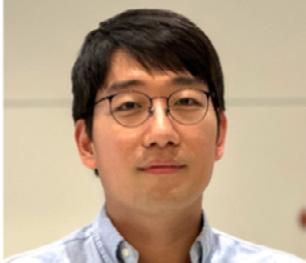
Inseung Kang joined MechE during the Spring ‘24 semester as an Assistant Professor. He works to enhance mobility using robotics, wearables, and AI.

Courtney Schreiner joined MechE as our Alumni Relations Manager. She is working to develop a lasting relationship between graduated students and the department, particularly serving as a source of information. She strives to create a community between MechE students, faculty, and alumni by providing ongoing engagement with alumni and expanding our current network of professionals wherever they live and work.

Kaz Shindle is the Program Coordinator for the Dean’s Office of Diversity, Equity & Inclusion and Mechanical Engineering. They organize a variety of different programs aimed at making a more equitable and inclusive environment in the College of Engineering, including student mentorship, cultural humility trainings, the intergroup dialogue program, and more.
MECHANICAL ENGINEERING 32
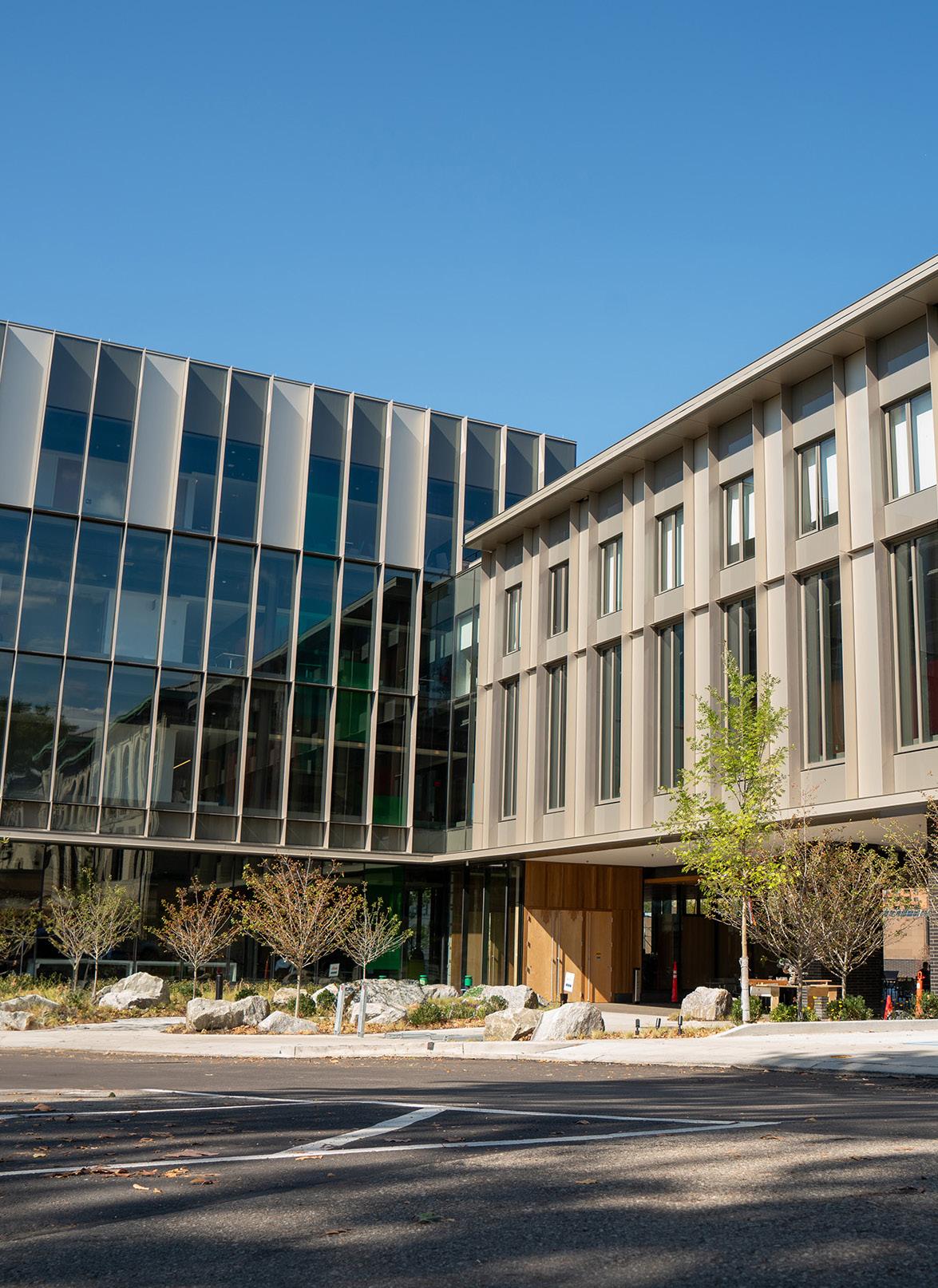
ALAN MAGEE SCAIFE HALL OF ENGINEERING
Please come to visit our new home for Mechanical Engineering at Carnegie Mellon next time you’re in Pittsburgh!
33 MECHANICAL ENGINEERING



CMU.Mech
CMU_Mech
CMU_MechE
meche.engineering.cmu.edu


April 11-14, 2024
Non-Profit Org. U.S. Postage PAID Pittsburgh, PA Permit No. 251
MECHANICAL ENGINEERING Carnegie Mellon University 5000 Forbes Avenue Pittsburgh, PA, 15213-3890









 Jon Cagan
David and Susan Coulter Head of Mechanical Engineering
George Tallman and Florence Barrett Ladd Professor
Jon Cagan
David and Susan Coulter Head of Mechanical Engineering
George Tallman and Florence Barrett Ladd Professor















































































